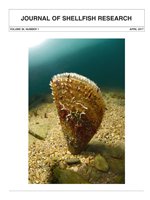The eastern oyster Crassostrea virginica once supported one of the largest fisheries in the eastern United States. Oyster populations and the reefs they form have suffered chronic long-term decline throughout the species' range, including in northwest Florida's Pensacola Bay estuary system (PBS). To guide efforts to rebuild oyster populations in the PBS, connectivity patterns were evaluated among historic and extant reef locations using an integrated biophysical numerical model. Water quality parameters and oyster recruitment were monitored in May 2007 and then monthly from July 2007 through July 2008. Resultant salinity data were used to calibrate an Estuarine Coastal Ocean Model—based numerical circulation model of Pensacola Bay, which was then coupled to an existing, individual-based, oyster larvae routine to predict ontogenetic larval distribution. Threedimensional Lagrangian transport algorithms were used to simulate transport of modeled larvae during four 20-day time periods during those summer and autumn months when oyster recruitment was empirically recorded in the bay. Based on outcomes from contemporaneous sampling of oyster larvae, the model was shown to represent the salient features of oyster larval distribution in Pensacola Bay. There were, however, instances of incongruity between modeled and sampled outcomes, indicating that model outcomes not validated with field data must be interpreted with caution. Larval supply was highly variable and spatially complex, but potentially limiting to successful recruitment and reef replenishment. Larval transfer rates within and among previously identified oyster reefs in Pensacola Bay were determined and were used to predict optimal oyster reef restoration or rehabilitation sites. Finally, larval exports from the bay were estimated and considered within the context of larval exchange among north Florida estuaries and potential repercussions to the long-term health of the Gulf of Mexico oyster metapopulation.
How to translate text using browser tools
1 April 2017
Applying a Coupled Biophysical Model to Predict Larval Dispersal and Source/Sink Relationships in a Depleted Metapopulation of the Eastern Oyster Crassostrea virginica
William S. Arnold,
Steven D. Meyers,
Stephen P. Geiger,
Mark E. Luther,
Diego Narváez,
Marc E. Frischer,
Eileen Hofmann
ACCESS THE FULL ARTICLE

Journal of Shellfish Research
Vol. 36 • No. 1
April 2017
Vol. 36 • No. 1
April 2017
Biophysical model
connectivity
Crassostrea virginica
Gulf of Mexico
Pensacola Bay
restoration




